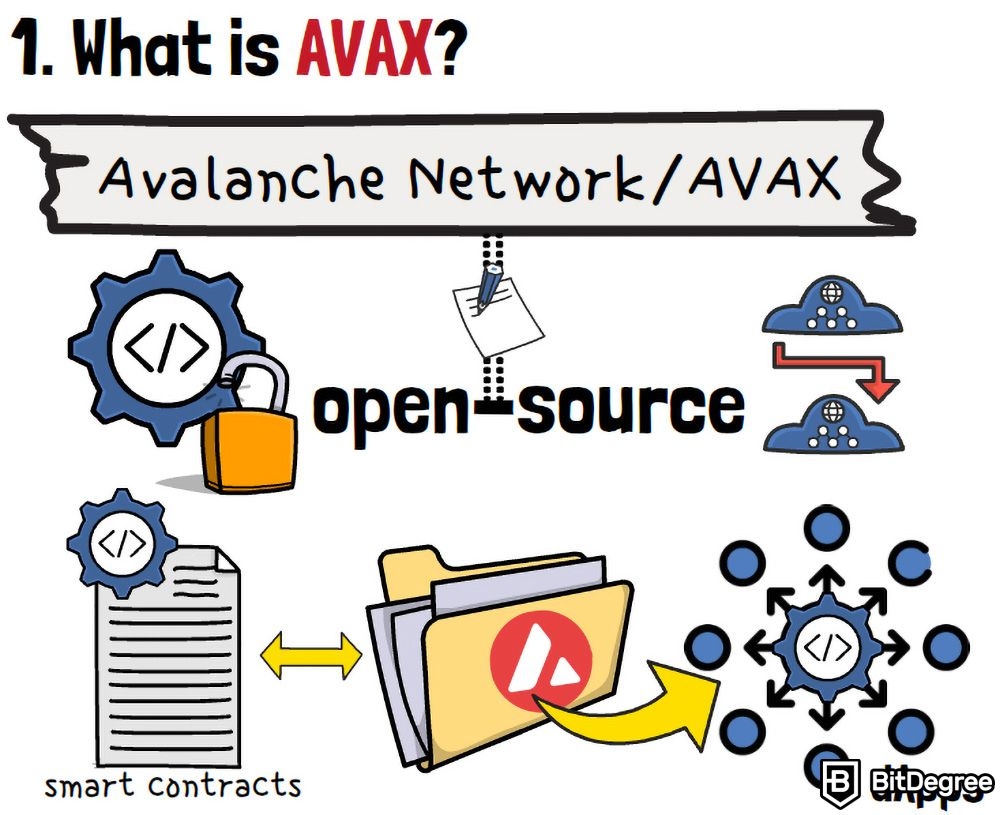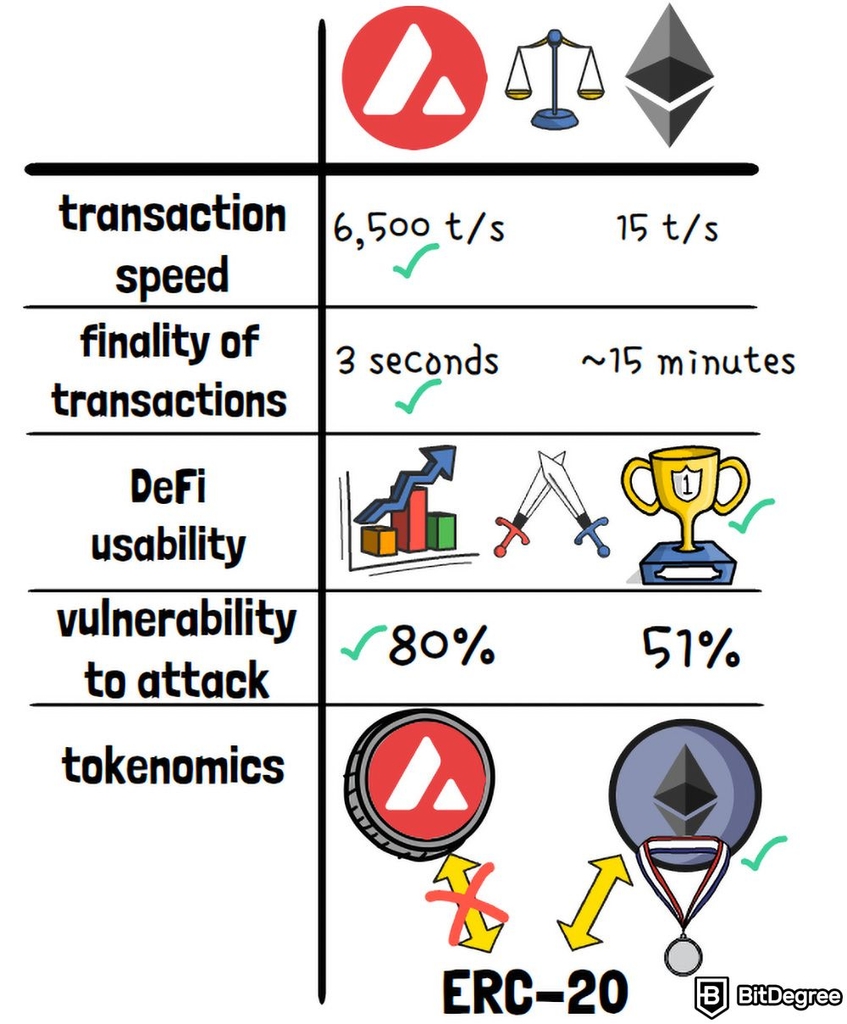2.18 Is Avalanche Network (AVAX) Rightfully Called the Future of DeFi?
Free Airdrop Season 7 is LIVE! Answer fun questions or do simple tasks to earn rewards from the $30K BitDegree prize pool. Participate Now ! 🔥
In this section, I’m going to tell you about what is Avalanche Network, or AVAX!
Five years ago, an anonymous group of individuals named “Team Rocket” tweeted their masterful idea that would tilt the crypto world on the side. And while you probably know the name from the anime, this “Team Rocket” was not planning to steal anyone’s Pokemon. Nor crypto, for that matter!
The mystery team came up with a new blockchain protocol that would combine two sets of rules: the Classical consensus and the Nakamoto consensus. Someone caught on to the idea and started experimenting, trying to create a network that was both scalable and robust, as well as speedy and decentralized. They created something bound to become a hallmark in crypto, and called it Avalanche.
In this section, I’m going to answer questions such as what is AVAX, what makes it so unique, and why should it be considered among the biggest competitors to industry giants such as Ethereum.
Let’s get right into it!

Video Explainer
Video Explainer: Is Avalanche Network (AVAX) Rightfully Called the Future of DeFi?
Reading is not your thing? Watch the "Is Avalanche Network (AVAX) Rightfully Called the Future of DeFi?" video explainer
What is AVAX? (Avalanche Network Explained With Animations)


What is AVAX?
First things first - what is AVAX? Allow me to explain it in simple terms!
Avalanche Network, or AVAX, is both a blockchain platform and a cryptocurrency, similar to the double-set you know as Ethereum. It’s an open-source, Proof-of-Stake crypto network using smart contracts to support its blockchain projects. Mainly, those projects include creating decentralized applications, or dApps.

Now, admittedly, I’ve just blurted out a lot of industry-specific terminology. If you’re unfamiliar with any of these terms, or would like a refresher, in general, make sure to check out other chapters of this Crypto 101 Handbook - there are sections covering all of those concepts in detail!
Like most blockchains, Avalanche also has a native token called AVAX. It serves as a utility token and has plenty of uses in the Avalanche ecosystem, including transactions, staking, and governance. But I’ll get to that in a minute; right now, let’s stay with the network itself!
So, like I said, “open-source” is one of the key terms to describe what is AVAX. Very generally speaking, it refers to data sharing and reciprocal operations.
Let’s say you’re doing a homework assignment requiring a lot of research. However, maybe the topic is super difficult, or maybe there just isn’t enough information online. So, naturally, you call your friend in a panic, asking if they found anything for the assignment, and lo and behold - they didn’t.
Now, you’re wondering if you should quit on the assignment altogether or write a mean letter to the teacher, but in the midst of your frustration, you accidentally find a book with the exact information you need. You’re an awesome friend, so knowing your classmates are also struggling, you go online and upload the info on Wikipedia, then send out the link so that everyone can access it.

Basically, you make valuable information available to all. This is what’s called interoperability - what you just did by gathering and sharing that info, so it won’t have to be collected again and is attainable to anyone looking for it.
Wikipedia, in this instance, is an open-source network, allowing anyone to distribute info, change it, and add to what’s important. In the same way, Avalanche allows its users to submit proposals for protocol changes.
Avalanche is known for tackling one of the main problems in crypto: scalability. The term refers to the network's capability of expanding and meeting the growing demand without declining its core functionality and features.
Let’s get back to the impossible homework example. So, you’re on your computer, researching intensely. You’re only finding tidbits of information on different sites, but they all seem somewhat useful, so you don’t close any of them, only adding more and more tabs on your browser, and your elderly computer is getting kind of tired. It starts wheezing and heating up, unable to handle such pressure.
Pretty frustrated with your computer now, huh?
Well, in the crypto world, your computer struggling would be called a scaling problem, which many crypto networks face. Crypto activity is largely growing, and many systems are unable to stay fast, cheap, and secure - transactions are declining, the prices are increasing, and the systems keep weakening.
However, the AVAX Network managed to come up with a solution - a unique system model that allows exceptional functionality, high speed, and low prices. It’s also one of the several things that make Avalanche so unique!
What Makes Avalanche Network Unique?
So, moving on, let’s see what’s actually so special about AVAX. It might be a bit difficult to grasp, but I’ll attempt to explain it in the easiest way possible!
First off, subnets! AVAX subnets are sets of validators working on three individual AVAX blockchain networks that have their own rules and functions, yet remain part of the primary network. It’s like having three employees at the restaurant - a waiter, a chef, and a host. They all have different jobs, but work towards the same goal in the same place, and are all equally important.
To begin with, we have the X-Chain, known as the Exchange chain. It’s mainly used to create Avalanche-based tokens, both fungible and non-fungible, or what you might know as NFTs.
The second one is called C-Chain, or the Contract chain. It’s super important that you know what is AVAX C-Chain! This one is responsible for hosting smart contracts and enabling the functionality of dApps. In this case, C-Chain is probably the restaurant's chef, the key to the whole operation.
Finally, we have the P-Chain or the Platform chain, which manages the validators. Similarly to other crypto networks, P-Chain allows you to stake AVAX tokens and easily become a transaction validator. Which brings me to my next point!

Avalanche uses a model called “Subsampled Voting.” Basically, it means that there’s a large number of volunteers who get randomly asked to check some things on the network and reach a unanimous answer.
For example - the validity of a transaction. A random group of users is asked whether the transaction should be accepted or rejected after the system initially chose to validate it.
What happens next is called network gossiping. Quite an amusing name, right? Basically, the participants get together to exchange information and opinions until reaching a consensus to accept or deny the transaction.
What makes AVAX’s validation system so special is that unlike with Proof-of-Work or other Proof-of-Stake mechanisms, the number of nodes, or validators, is irrelevant - the consensus will still be reached.
Another thing to add to answering what is AVAX is its unusual design. As you’ve probably gathered, AVAX is powered by, well, AVAX, the network’s native token. But what else?
Slush, Snowflake, Snowball, and Avalanche! Did you just imagine a crew of four superhero penguins in a cartoon? Well, the crew is actually called the Snow family, and they are not superhero penguins, but the four mechanisms of the Avalanche protocol. Basically, these four are what you get from combining the Classical consensus and the Nakamoto consensus, as I mentioned in the beginning.
Imagine you’re designing the newest iPhone. You want it to be optimized and the best variation there has ever been, of course. So, you take the key functions of the earlier iPhones that still resonate with Apple users, and add the newest features, so that the phone is still familiar, but also up-to-date, too.
The Snow family combo and unique Avalanche protocol are what made the network secure and easy to scale, eventually leading it to be one of the major crypto sensations.
Why Does it Rival Ethereum?
But does that sensation really pose a threat to the most widespread and usable network of all? The so-called “Global Computer”, Ethereum? Which, by the way, I have a whole separate section about, so I suggest you check it out!
We all know that Ethereum has some fancy names associated with it, like the aforementioned “Global Computer” or “Blockchain 2.0”. However, Avalanche, true to its name, has been crashing down on the cryptocurrency world with an even more forceful label - “the future of DeFi”.

Quite a majestic name, right? Well, with its unique features, improved protocols, and enormous scalability, the system truly threatens to become “Blockchain 3.0”. And if you’re still doubtful, or still question what is AVAX compared to Ethereum, just allow me to name some basic differences between the two.
First of all, Avalanche claims much faster transaction speeds - in one second, AVAX is theoretically able to carry out more than 6,500 transactions, whereas Ethereum can only handle 15. Also, on AVAX, transactions are usually finalized in under three seconds.
Next up, considering DeFi usability, it’s kind of hard to say which is better. For now, sure, Ethereum is much more popular and accepted. The years of trust and high-profile project development did their thing, but with the speed at which Avalanche is growing, ETH is surely facing some serious competition!
The Avalanche Network is also much harder to attack. I won’t delve into the technicalities, but in short, it would take the attacker controlling 51% of staked assets to breach Ethereum - for AVAX, that number goes up to about 80%.
Token-wise, ETH is winning, of course. It’s hard to replace the second most popular cryptocurrency, after all! However, speaking of tokens, AVAX lacks something that ultimately puts Ethereum forward. It’s not compatible with the ERC-20 standard. Let me explain.

Let’s say you acquire some AVAX coins. You may want to use them on a crypto application like AAVE, which is basically just a platform that allows you to earn interest by lending your crypto. However, AAVE is based on the Ethereum blockchain, and it won’t allow you to do anything with your AVAX, since it’s not compatible with the token standard of ETH, called ERC-20.
Defeat? No! You’ll just have to wrap up your AVAX. But what is wrapped AVAX, then? Actually, “wrapped tokens” are a bit of a complicated topic, but for now, I’ll explain it shortly.
Let’s say you decide to go diving. Obviously, you won’t plunge into the deep end with your trunks and nothing else - you need a diver’s suit for protection and oxygen. So, the suit serves as a tool to help you navigate an environment that’s completely alien to you. Right?
Well, the same can be said about wrapped tokens, as well. Wrapped tokens are a means to communicate between blockchains, so that you could use equivalent native assets of a specific protocol on other, non-compatible ones.
Wrapping Up
Now, I have to admit - answering the question of what is AVAX and presenting the many intricacies it has can be a challenge, but let’s recap what we know so far.
Avalanche takes the general trilemma of scalability, security, and decentralization, and addresses it all with its multi-chain design and a unique consensus mechanism - becoming a breath of fresh air in the crypto space! Also, it has its very own native token, AVAX, which you can actually find on your usual crypto exchanges, like Binance or Coinbase.
In the end, though, Avalanche has many more attributes that are a bit too complicated to tackle in one short section.










